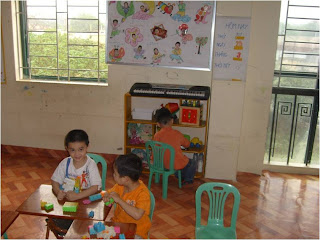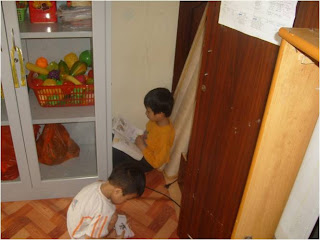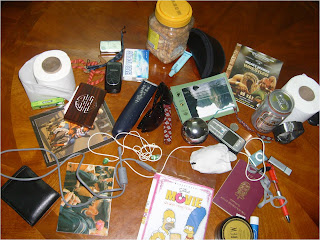At this meeting we will like to share our experiences from our work with children in Denmark. But first we will start by telling you about our education in Denmark, what are we training to become… We all study to become social workers or pedagogues as we call it in Denmark. That profession is about taking care of children, adolescents or adults who need it. It may be in kindergartens and leisurecenters the main thing for social workers here is to give children and young people care and support so they can develop personally and socially. You play and talk with the children and provide experiences and activities to stimulate language, development and children’s imagination and creativity. The important thing is that it should be child-centered learning, the child and it´s needs must be in focus and not the adults. As a social worker you can also work with children, adolescents and adults who have physical or mental disability. It may be people who are blind, brain damaged or has a disability movement. The work can take place in residents’ own homes, in institutions and in schools. Here your mission is to support, guide and train individuals so that he or she can cope with a normal daily life. We learn the children the same things as you but our approach to them is a little different than here in Vietnam. This approach is the experience that we would like to share with you today.
At this meeting we will shortly talk about what autism is and how it affects the brain and behavior of autistic people. Whats good to be aware of when we interact with a child with autism and what methods we can use so the child benefits from it. Using recognition as a method and approach to the child.
Basic autism
Autism is a handicap that you are born with; it is a disfunction in the brain.
Three things that characterizes autism:
Social behavior or norms, lack or delayed verbal language and abnormal and challenging behavior.
Problems sorting the senses
Every minute our brain receives 11.000 impressions from our senses. A normal brain I capable of sorting these impressions down to 40, this is a autistic brain not capable of, they get all these impressions into their mind. (Illustration)
The two different kind of brains.
A normal brain.

An autistic brain.

This is why some autistic people react very strongly to certain things; this might be sounds, colors or similar things. This is very important when you work with autistic people to remember these things so you don´t cross the persons boundaries and violate the personal space.
Examples
· If you go in from behind and lift up an autistic person you might get a big reaction if the person isn´t aware of your intentions.
· If you want to deliver a message to an autistic brain make sure that the person is aware that you are talking to him or her, by making sure that the person is looking at you or demanding an answer.
The lack of ability to sort the impressions from your sense is why the autistic person is having it much easier if the messages you want to send is loud and clear.
Communication
Messages that is loud and clear:
Before you meet an autistic person with a demand, you have to consider if the person is capable of meeting this demand, if you reach to the decision that it is a reasonable demand you go through with it, if the demand isn´t reasonable don´t present the demand to the person, it is a possible situation of an unnecessary conflict.
 Example
ExampleA child keep getting up from his or her chair, if you mean it is possible for this child to sit still you keep demanding the child to sit still, if you don´t mean it is possible look for an alternative, for example. Sitting on the floor.
Methods for challenging behavior
The tone of voice
If a child is conflicting, it might help to show the child that you are calm and in control by your tone of voice, keep your voice on a level that isn´t loud, maybe tell the child that you are aware that it is in a situation that isn´t comfortable.
If this doesn´t work you might consider giving the child a break.
Break
When the autistic person are having trouble controlling the impressions, it might be a good idea to give the child a break, by putting the child in a place where it feels comfortable and safe, it might be in a certain place in the classroom, for example in a corner. Sometimes it is an idea to use a watch to show the child how long time it has to stay there.
This isn´t a punishment it is a help!!


Kims Game
Then we have an activity for teachers “Kims game”.
We will show 2 pictures, and the teachers have 30 seconds to watch every picture and memorizing the items, afterwards they are going to tell which items there are on the pictures.
There are one picture which is easy and one that is hard, the easy one represent the normal brain, and the hard one represent the autistic brain, this shows how much the autistic brain have to remember compared to the normal brain, because of the lack of sorting out impressions.


In the class, the children are sometimes very focused on what is going on in the other groups, and even though the child might look it has trouble keeping focus, they are actually making an enormous effort to keep all the impressions under control and stay focused.
4 elements of recognition.
Recognition is a difficult size to define, but we will try by taking concepts such as empathy, understanding and compassion in the other (the child).
• Understanding – We try to understand the other's meaning and intention behind that we are actively listening when we are present on the second and openness.
• Confirmation – To communicate our understanding of the other's situation back omits praise and rice because it is an appreciation on our part. That we reflect and repeat the other. That we provide open and wondering questions.
• Transparency – The fact that we give up control and management, so that we do not evaluate.
• Self-reflection and distinguishes – That we are reflective in relation to our own feelings, experiences and reactions. That we distinguish between our own and other's experiences.
To make the recognition visual, we will show some video clip and try to explain recognition further.
Empathy
Means to try to understand the child, its intentions and feelings, by taking in the child's point of view.
The reason why empathy is important is that the child feels understood and accepted, and through understanding and accepting the child develops the capacity for self-exploration and thus draw the lessons from its experience, the child becomes independent and able to handle more and more things themselves, which is the target of sao mai.
Eg. When the child is tired of it and you go in and take comfort that supports around its self-image and recognize that the child is sad. This shows that you have seen the child is tired of it and that you are trying to understand the child's feelings.
Eg. When the child in eating situations pull their heads away from the spoon, or pushes the bowl away from them, when we see this we recognize it, accept it and take the food away.
Exsamples on recognition
E.g. When a child has made a drawing, you can talk about what kind of colour or patteren the child have drawn. This shows that you have an interest in what the childs is drawing, which can open for a communication between you and the child.
E.g. When a child is telling something to you, then sit down in front of the child, make eye-contact and listen to what the child is saying. The child will feel that you are interested in what its saying.
E.g. When you have to say something to a child, then stand or sit in front of it. So the child knows that it is him/her you are taking to.
E.g. If the children one day are going to play with blocks, and one child don’t like to play with blocks. Then you can give the child some toys that you know that it likes. For eksample if the child likes toy animals. When you reconice that the child don’t like to play with the blocks, the child will be glad and feel that it’s being understood.
Recognize communication
In our work with children with autism it is important to be aware of our communications because they may not master verbal communication. That is why we trough our knowledge and our relationship to the child must pay attention to the non-verbal communication (mimic, tone and body language), which may use alternative forms of communication, board maker, characters to talk.
Recognition in the relationship between the children and the teacher: In Denmark we are talking a lot about Recognition in the relationship between the children and the teacher. We have been talking a little bit about the basic elements of recognition and will now talk a bit about recognition in relations, e.g. the relationship between teacher and child. In Denmark, we believe in that it is in relationship to the other (child), the educational work is carried out. To consider the relation as a recognition relationship, it needs to be equal, e.g. The child's experience of the situation is at least as important as the adults.
Appreciative relation
•In Denmark, we believe that it is in the relation to the other (child), the pedagogical work is carried out. For the relation to the other is appreciative, it has to be equal, that is to say that the child’s experience of the situation is least as important as the adults.
•The appreciative relation makes the learning process easier and better.
The recognition of the child, helping to increase the child's belief in itself and it makes the child independent. As both teachers and parents have a very important role in the child's life, it is important that both parts recognizes the child as the child is an experience of having something to offer in relationship to others and life, and this also promotes the desire to learn new things.
